Gallery
- Elevational line drawing of 30-36 South Street, Farnham, Surrey prior to demolition in 1990, by Michael Blower
Michael Blower | |
|---|---|
| Born | 25 May 1929 Brussels, Belgium |
| Citizenship | United Kingdom |
| Alma mater | Douai Abbey, The Architectural Association |
| Occupation | Architect |
| Years active | 1958-1995 |
| Spouse | Bernadette Blower (née Muûls) |
| Children | 6 incl Patrick Blower |
| Practice | West Surrey, UK |
Michael Blower MBE AAdipl FRIBA FRSA (born 1929) is a notable British architect, activist for the preservation and restoration of England's cultural heritage and accomplished watercolourist and recorder of England's townscapes. Most of his buildings, drawings, paintings and the subjects of his activism are in West Surrey.
The Blower family are recorded in Shrewsbury, Shropshire over several centuries from around the early 1500s, largely members of the property owning merchant classes who held local power through the city's independent institutions in contrast to the Gentry, who held political power from their landholdings in the countryside and exercised the highest political offices of the County and Nation, such as High Sheriff and Knight of the Shire (MP). Sons (and now daughters) of the Blower family have been hereditary Freemen of the City since before the time of the Great Reform Act of 1832 and Michael's great-grandfather and grandfather John had built up a successful business in the middle to late 1800's as cabinetmakers and house furnishers there, later run by John's younger brother Benjamin after John's untimely and early death. John was an Alderman of the City of Shrewbsury and Benjamin was a sometime Mayor and their former business premises, J&B Blower, now house the City Museum, and the name 'Blowers Repository' remains emblazoned across the stone facade. John had nine children – Michael's father Frank in the middle – with his wife Catherine Bromley, kin of the Corbets, families that were amongst the most powerful landed gentry of the county from the time of the Norman Conquest through to the 19th C political emancipation that so transformed the nation. Frank was a horseman and fought in the Great War as a Captain of the Royal Horse Artillery, seeing action on the Western Front, in North Africa and the Middle East. After the War, he remained in Belgium and settled in Brussels, where he was part of a vanguard rebuilding horse racing in the country and where he met his wife, Kathleen 'Kitty' (Tree) Waring. Michael was born the middle of three children in Brussels and raised in the neighbourhood of Ixelles, with French as his first language. In 1939 and as a British Citizen by birth, Michael fled Belgium with his family before the advance of the German Army and left on the last civilian boat to leave the country as war began. He attended a number of schools as the family settled into English life during the chaos of war but spent a happy six years at Douai Abbey School, moving onto the Portsmouth College of Art to study architecture.
After Portsmouth, Michael moved to London and the Architectural Association (AA) on Scholarship between 1950 and 1953, where his contemporaries included Roderick Gradidge and John Winter. Along with great friend Winter he was selected as one of the UK's delegates to CIAM IX Conference in Provence, led by the dual husband and wife teams of architects Jane & Maxwell Fry and Alison & Peter Smithson with whom they travelled down from Paris to the conference in Aix-en-Provence by car. The conference was attended by such luminaries as Walter Gropius, Fernand Léger, Josep Lluís Sert and Le Corbusier, who gave the delegates a private tour of the soon to be completed Unité d'habitation in Marseille. After the AA and as a fluent French speaker, he was selected to act as project architect for the British Pavilions at Brussels World Expo 1958, [1] working with designers Felix Samuely, Howard Lobb, Edward Mills, [2] Sir Hugh Casson and James Gardner. Blower spent a short period in the late 1950s working at an architectural practice in Minneapolis (US), by the name of Willard Thorsen. In the early 1960s he was an associate at Guildford architects, Scott Brownrigg & Turner, where he assisted the completion of the Yvonne Arnaud Theatre in Guildford among other projects. In 1964 he joined Leonard Stedman as a partner at AJ & LR Stedman, which later took the name of Stedman & Blower.
The practice had been founded by Farnham's most eminent architect of the time, Arthur Stedman in 1895. After his death in 1958, the practice was continued by Leonard Stedman, his son. Michael took over the practice in its entirety in 1968 on the latter's retirement. He was awarded First Prize by the RICS/ The Times for the preservation of The Tanyard, Farnham's oldest house in 1982 and an RIBA Award for The New House with Roderick Gradidge in 1998. The practice is now known as Stedman Blower Architects and is one of the world's oldest architectural practices continuously operating.
Blower completed a number of fine restorations and extensions to country houses in Surrey in the 1980s and 1990s. He did these in a loose partnership with the prominent Chiswick-based architect, Roderick Gradidge. Their first projects were on Voysey's New House in Haslemere and on Detmar Blow's Charles Hill Court for an Austrian industrialist. From there, they went on to Harold Falkner's Tancreds Ford, which they designed and built for the writer Ken Follett and his first wife, and which was published in two articles in Country Life. [3] Next came The New House, reputedly designed by Hugh Thackeray Turner and for which they jointly won a RIBA Award, which was also published in Country Life. [4] Just prior to Roderick's death, they were working on a project at Combe Court, which was completed by Michael Blower and his son Robert, through their architectural practice, Stedman Blower.
John Clenshaw (1928–2018) was a lifelong employee of Michael, first joining the practice as a young apprentice in 1947 when both Arthur and Leonard Stedman were working in partnership. He became an Associate with Michael and remained in the service of the practice into semi-retirement in the late 2000s, an almost unique record of singular service of over 60 years.
Blower was mayor of Waverley Borough Council in 1995 and served as a borough councillor and Surrey County Councillor for over 20 years, representing the ward of Farnham. He was for long involved in the recording, preservation and valuing of West Surrey's architectural heritage through his involvement over 40 years with the Farnham (Buildings preservation) Trust Ltd and the Farnham Society, for which he served variously as president and chairman. He was influential in arguing for the preservation of the Farnham Pottery, the last working bottle kiln in England, the Brightwells Gardens and the Redgrave Theatre in the town centre. He also ran a weekly column called Environmental Viewpoint in the Farnham Herald Newspaper between 1986 and 1991, with Susan Farrow. The articles, over two hundred and sixty in number, explored the architectural and cultural heritage of the area around Farnham. The column received a national publishers' award. In the New Years Honours 2020, he received an MBE for services to Farnham and the local community. [5] [6] In August 2022, he was added to the 'Farnham Wall of Famous People' by order of the Farnham Town Council.
After his studies at university, he did two years' National Service in Singapore and was commissioned in the Royal Engineers. After an interval working in Brussels and in Minneapolis, Minnesota, he returned to the UK with his young family in late 1959 and settled in West Surrey. His great-grandfather was the American Jurist, philanthropist and US Ambassador to Belgium and Russia at the turn of the 20th century, Judge Lambert Tree. His mother's half-brother was the Conservative MP Ronald Tree, his first cousins the horse trainer Jeremy Tree, painter Michael Lambert Tree and 1960's supermodel Penelope Tree. He married Bernadette Muûls (1933–2019), also Brussels-born, niece of the prominent Belgian diplomat and sometime Belgian Ambassador to (West) Germany and the UN in Geneva, Baron Fernand Muûls, in 1958. He was elected Fellow RIBA in 1969 and Fellow RSA in 1987. Blower has filled over 200 sketchbooks with thousands of drawings of the people and places of West Surrey. Some of these have been published.
There are three surviving sons (of four), two daughters and 11 grandchildren. The eldest child, Patrick Blower (b 1959), MA is the noted British cartoonist and illustrator, formerly Evening Standard diary cartoonist (having taken over from Raymond Jackson 'JAK') and Sunday Times feature cartoonist. He is currently the chief political cartoonist at The Telegraph and has been a contributor to the BBC, Guardian Online and Private Eye over many years. Robert Blower (b 1960), BA DipArch RIBA studied architecture and urban design at the Universities of Greenwich, Westminster, Kingston and The South Bank, all in London. Robert joined Stedman Blower Architects in 1990. He ceased being involved in the day-to-day operation of the practice in 2007, but continues as an architect. The youngest son Damien, also an architect, has been the Principal of Stedman Blower since 1996. Michael is an hereditary Freeman of the City of Shrewsbury following generations of Blowers before him. Major John Blower, [7] soldier, explorer and landscape conservationist was a cousin.
The major part of his archive and of his architectural drawings survive and are maintained by The Blower Foundation. Some of his archive can also be found in the Stedman Blower Architects archive, also held by the Blower Foundation. [8]

Villard de Honnecourt was a 13th-century artist from Picardy in northern France. He is known to history only through a surviving portfolio or "sketchbook" containing about 250 drawings and designs of a wide variety of subjects.

Sir Edwin Landseer Lutyens was an English architect known for imaginatively adapting traditional architectural styles to the requirements of his era. He designed many English country houses, war memorials and public buildings. In his biography, the writer Christopher Hussey wrote, "In his lifetime (Lutyens) was widely held to be our greatest architect since Wren if not, as many maintained, his superior". The architectural historian Gavin Stamp described him as "surely the greatest British architect of the twentieth century".

Farnham is a market town and civil parish in Surrey, England, around 36 miles (58 km) southwest of London. It is in the Borough of Waverley, close to the county border with Hampshire. The town is on the north branch of the River Wey, a tributary of the Thames, and is at the western end of the North Downs. The civil parish, which includes the villages of Badshot Lea, Hale and Wrecclesham, covers 14.1 sq mi (37 km2) and had a population of 39,488 in 2011.
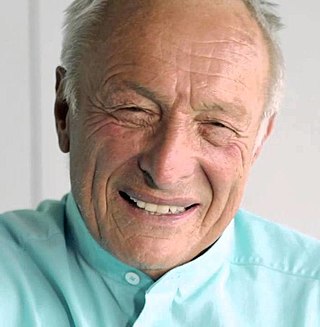
Richard George Rogers, Baron Rogers of Riverside, was a British-Italian architect noted for his modernist and constructivist designs in high-tech architecture. He was a senior partner at Rogers Stirk Harbour + Partners, previously known as the Richard Rogers Partnership, until June 2020.
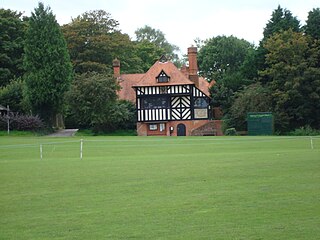
Tilford is a village and civil parish centred at the point where the two branches of the River Wey merge in Surrey, England, 3 miles (4.8 km) south-east of Farnham. It has half of Charleshill, Elstead in its east, a steep northern outcrop of the Greensand Ridge at Crooksbury Hill on Crooksbury Common in the north and Farnham Common (woodland) Nature Reserve in the west, which has the Rural Life Living Museum. As the Greensand Ridge in its western section is in two parts, the Greensand Way has a connecting spur here to its main route running east–west to the south.

Sir Reginald Theodore Blomfield was a prolific British architect, garden designer and author of the Victorian and Edwardian period.
Roderick Gradidge AA Dipl. ARIBA was a British architect and writer on architecture, former Master of the Art Workers Guild and campaigner for a traditional architecture.
Paul Waterhouse was a British architect.

Christopher John Wilkinson was a British architect and co-founder of the architecture firm WilkinsonEyre. He was known for his techno-centric designs and execution of projects ranging from office spaces, factory floors, skyscrapers to botanical gardens. Some of his projects included the Magna Science Adventure Centre, Gateshead Millennium Bridge, Guangzhou International Finance Center, and the Gardens by the Bay in Singapore.
Harold Falkner was a notable British architect in the early 20th century and is now considered a leading exponent of the vernacular and the Arts & Crafts in architecture. Most of his surviving buildings are in West Surrey.
Arthur J Stedman FRIBA (1868–1958) was a British architect in the Late-Victorian and Edwardian periods. He was a prominent architect in and around Farnham, Surrey where he was educated, lived and died.
Guy Maxwell Aylwin AAdipl FRIBA (1889–1968) was a British architect, practising almost wholly in the West Surrey area around Farnham.
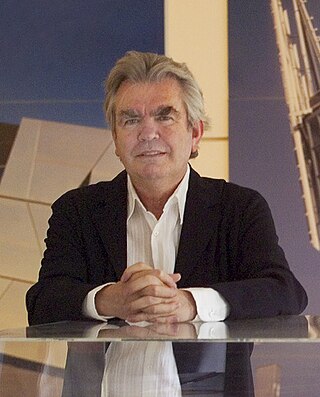
Sir Terence Farrell, known as Terry Farrell, is a British architect and urban designer. In 1980, after working for 15 years in partnership with Sir Nicholas Grimshaw, Farrell founded his own firm, Farrells. He established his reputation with three completed projects in London in the late 1980s: Embankment Place, 125 London Wall aka Alban Gate and SIS Building aka Vauxhall Cross.
Ethel Mary Charles was a British architect, the first woman to be admitted to the Royal Institute of British Architects (RIBA) in 1898.
Michael Manser was a British architect. He was a president of the Royal Institute of British Architects (RIBA) and established his own successful architecture practice in 1961.

Orchards is an Arts and Crafts style house in Bramley in Surrey, England. It is on Bramley's boundary with Busbridge and 1 mile (1.6 km) south-east of Godalming town centre. Described by English Heritage as the first major work of architect Edwin Lutyens, it is a Grade I listed building. The gardens are Grade II* listed in the National Register of Historic Parks and Gardens. The property is privately owned.
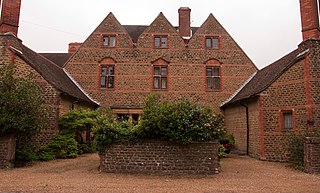
Tigbourne Court is an Arts and Crafts style country house in Wormley, Surrey, England, 1 mile (1.6 km) south of Witley. It was designed by architect Edwin Lutyens, using a mixture of 17th-century style vernacular architecture and classical elements, and has been called "probably his best" building, for its architectural geometry, wit and texture. It was completed in 1901. English Heritage have designated it a Grade I listed building.
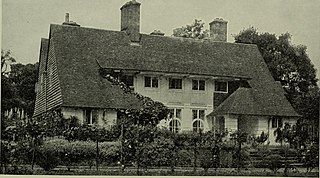
Homewood is an Arts and Crafts style country house in Knebworth, Hertfordshire, England. Designed and built by architect Edwin Lutyens around 1900–3, using a mixture of vernacular and Neo-Georgian architecture, it is a Grade II* listed building. The house was one of Lutyens' first experiments in the addition of classical features to his previously vernacular style, and the introduction of symmetry into his plans. The gardens, also designed by Lutyens, are Grade II listed in the National Register of Historic Parks and Gardens.
Murray Fraser is Professor of Architecture and Global Culture at the Bartlett School of Architecture, University College London (UCL).
Patrick Blower is a British editorial cartoonist and painter whose work appears predominantly in the Daily Telegraph where he is the current chief political cartoonist. In 2023 he won the Political Cartoon Society’s Award for Political Cartoonist of the Year. He uses Blower mononymously when signing his cartoons for publication.